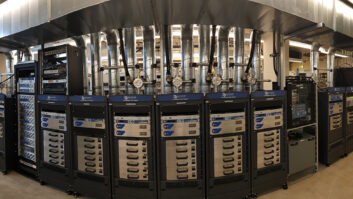Trends in Technology: AES-X210, The “Missing Piece” of AES67?
Jan 1, 2015 9:00 AM, Doug Irwin, CPBE AMD DRB
I believe most of us would agree that standards in communication protocols are of great benefit to our work in broadcasting. One only needs to consider Ethernet and IP if you are not thoroughly convinced.
In this article, we”re going to discuss Open Control Architecture, also currently known as AES-X210. It”s a proposed standard for what I would loosely call �machine control� over IP. But first let”s put it into context. In the pages of Radio we”ve discussed communications protocols extensively over the last several years.I”ve contributed several articles that are germane to the topic � the first was about the AVB standard. More recently, I”ve written about AES67, certainly an important topic if you make use of audio over IP.
In a nutshell, AES67 is a standard for audio over IP transport, allowing different manufacturers” equipment to �talk� to one another. However, AES67 is only for audio transport, and there are important functions that broadcasters are accustomed to that are not considered. �[T]here”s a whole world of other functionality that broadcasters expect, like device start/stop functions, monitor mutes, on-air tallies, the ability to control peripherals from the console, the ability to know when an audio source is live and ready for air, the ability for playout systems to control fader on/off functions and more. Those are functions that AES67 alone doesn”t provide for,� said Marty Sacks, vice president of equipment manufacturer Axia.Sacks continued, �AES67 is a great start toward a unified standard, but when the first AES67 devices hit the marketplace, they will also need to support this additional functionality, no matter whose system they use, in order to provide an integrated control experience for the user � otherwise they”re going to be no better than AES3 streams, with serial GPI cables running alongside.�Andrew Calvanese, Wheatstone vice president of engineering, expressed similar sentiments. �AES67 is the first step in what we hope will lead to a totally interoperable environment that includes not only transport, but the means to control and discover all devices and functions within the network. We are working with other engineering teams to standardize on the control and discovery protocols that can make that happen at an overall, interoperable level.�
Now to the topic at hand: AES-X210, or �Open Control Architecture.�
OCA Alliance at AES 2014
�
OCA is meant to be an open standard that will allow for �the control and monitoring of media networks, not for the transmission of media content,� said Jeff Berryman, senior scientist at Bosch Communications (one of nine members of the OCA alliance). �When the X210 project is complete, it will yield a set of standards for control and monitoring of media networks. OCA will work with any of the current and emerging media transport standards such as AES67, AVB, Cobranet, etc.�
What kind of features can we expect to be supported in the future? In OCA version 1.1, we have the following, among others:
�
- � Gain controls
- � Muting
- � Switch position (up to n positions)
- � Matrices
- � Cross fading
- � Level sensors (meters)
�
The OCA Alliance recognizes that OCA has many applications related to broadcasting, including:
�
- � Widespread networks, with perhaps thousands of nodes
- � Transcontinental networks using leased facilities, for IP
- transmission
- � Interfaces to broadcast mixers
- � Voice over IP interfaces
- � Portable and/or fixed location nodes
- � Multiple subnets, multiple sites, multiple work environments,
- some of which could be different locations
- � Configuration/Administration by IT departments
�
OCA Alliance Device Model (EDN magazine)
�
The OCA Alliance has published a detailed set of design parameters, the entirety of which is available from their website at ocaalliance.com.
Now let”s move on to greater detail, or what OCAA calls �architectural goals and constraints.�
Functionality: OCA will by design allow for the discovery of all OCA compliant devices attached to the network. It will manage media streaming connections. In other words, it will �set up� and �tear down� streams between devices. It will control operating and configuration parameters of OCA compliant devices, and it will monitor operating and configuration parameters between OCA-compliant devices. For devices with reconfigurable signal processing and/or control capabilities, it will allow the user to define and manage configuration parameters. The upgrade process for software and firmware will include fail-safe features.
Security: The following security measures will be offered for control data: entity authentication, prevention of eavesdropping, integrity protection and freshness (protection against old data).
Scalability: OCA will impose minimum restrictions of the physical distribution of application devices, and the number of devices. The design will allow for the control and monitoring of up to 10,000 devices in one system.
Robustness: OCA guarantees robustness by offering mechanisms for operational confirmation, for handling the loss of control data and for failures of OCA-compliant devices. It also will provide recommendations on network robustness that can be deployed in the system.
Compatibility: OCA will be able to detect and work with different network interface versions. In the event of incompatibilities due to differences in versions, a report will be generated for the incompatible device. OCA is designed as an extensible protocol, meaning that it is likely to be modified in later versions. The goal is forward and backward compatibility.
Analysis: OCA will offer diagnostic functions that will allow access to the version numbers of the software and hardware on compatible devices, the network parameters of those devices, network status, packet errors, and media stream parameters for each active stream to or from a device.
Another design goal is for OCA to be simple. For a network of less than 100 nodes using recommended layer 2 switches, the setup should not require any advanced knowledge of IP networking. OCA networks will operate on industry-standard network hardware in a secure or unsecure mode. OCA compatible devices will be able to coexist on a network shared with non-compatible devices, and OCA provides a well-defined means for the incorporation of non-standard devices in a �maximally compatible� way.
OCA (AES-X210) includes multiple protocol versions that support different kinds of interconnections. The current version protocol is for IP networks but it is anticipated that future versions will work with other types of connections, such as USB.As a follow-up to my questions from last year about AES67, I asked Andrew Calvanese of Wheatstone his thoughts on whether or not the issues raised back then will be addressed by AES-X210.
�How well the concerns are addressed will depend on the ultimate form of the standard and how comprehensive it will be. The AES-X210 working group”s intention on using the OCA work originally started quite a few years ago and could be a great step forward in interoperability as it provides for visibility and access over a network into the internal functions of a networked media device. This kind of control capability greatly enhances the utility of (and is a driving reason for) having an IP media network in the first place.
If it becomes a standard as is anticipated, its usefulness will depend on the industry manufacturers and their individual interests in implementing the standard. For those that don”t have IP control, there could be significant effort involved.�
I also asked Calvanese about when any newly ratified standards, derived from AES-X210, would start to show up in their AoIP systems. �As we have had IP control interfaces in place for the past 14 years, for us it will be straightforward (and is our intention) to implement a compliant control layer as soon as a standard is ratified.�
Greg Shay, chief science officer of the Telos Alliance, shared his thoughts on the potential of AES-X210.
�As you well know, the biggest technical trend in the audio broadcast industry that has transformed how facilities are built and how day to day work gets done has been the leveraging of IT and computer technology by carrying audio over the IP network,� he said.
�The benefits of the IP network are certainly more than efficiently transporting hundreds and thousands of channels of audio. The full benefit of the IP network is about interconnecting equipment, and the people who use that equipment, to get all manner of work done. Control of the equipment, efficiently, quickly, accurately and independent of physical location is ideally suited for an IP network solution.
A standard, well-accepted network-based control protocol would enable broadcast customers to take yet more advantage of the power of the network. We are firmly in the camp of knowing the value of an inter-vendor network control protocol, but also are watching very closely for which is the right protocol to choose. I do believe AES-X210 is a very strong contender, and am closely watching its progress.�
Whether or not OCA becomes a standard along the lines of AES67 remains to be seen, of course. Clearly the industry knows the need is out there. I believe it will be very interesting to see the evolution of AoIP systems over the next 5 to 10 years, and I hope that the coming of new standards will increase the acceptance of this type of system in more radio plants.












